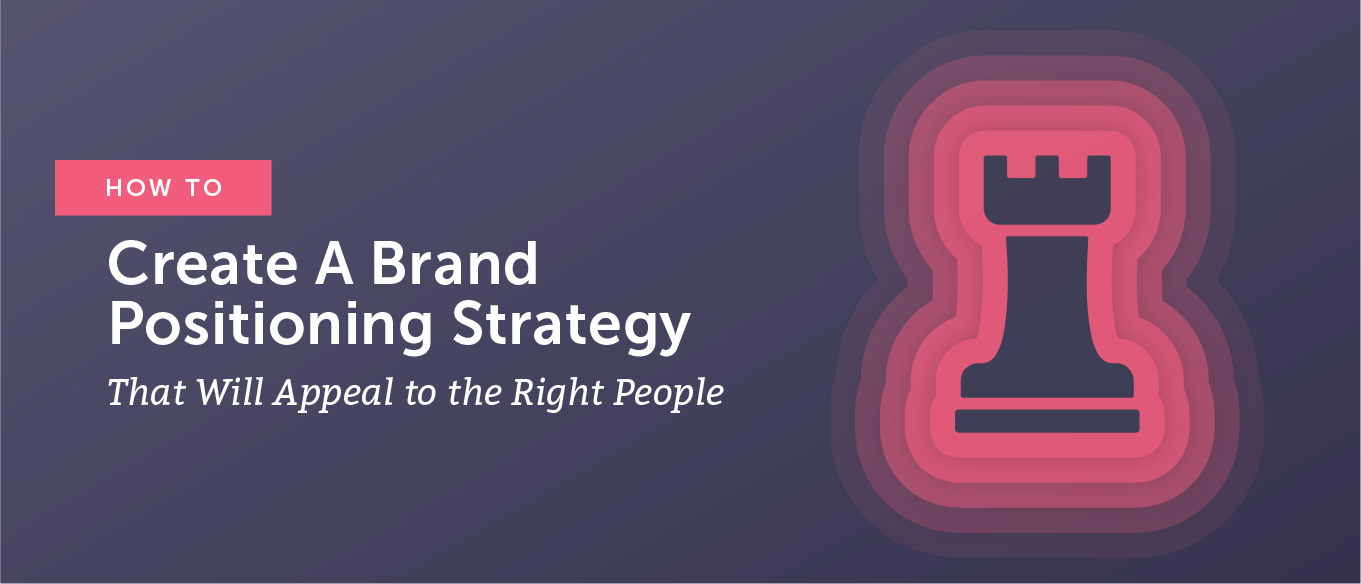You’ve probably heard that a brand is more than a logo, product, or service.
Each is true.
It’s an umbrella that spans from social media branding to user personas to voice and tone to everything in between.
In some ways, it’s even more because it’s all of these things packaged up and presented — then unpacked and cracked open, so the world can see the gooey insides.
In simplest terms, a brand has three components:
- Feeling: a gut-level reaction.
- Promise: the vow a brand makes to its audience.
- Relationship: the quality of ongoing interactions between a brand and its audience.
In order to build a great brand, you need to bring them all together in a simple, energizing way to craft a brand strategy that appeals to the right people.
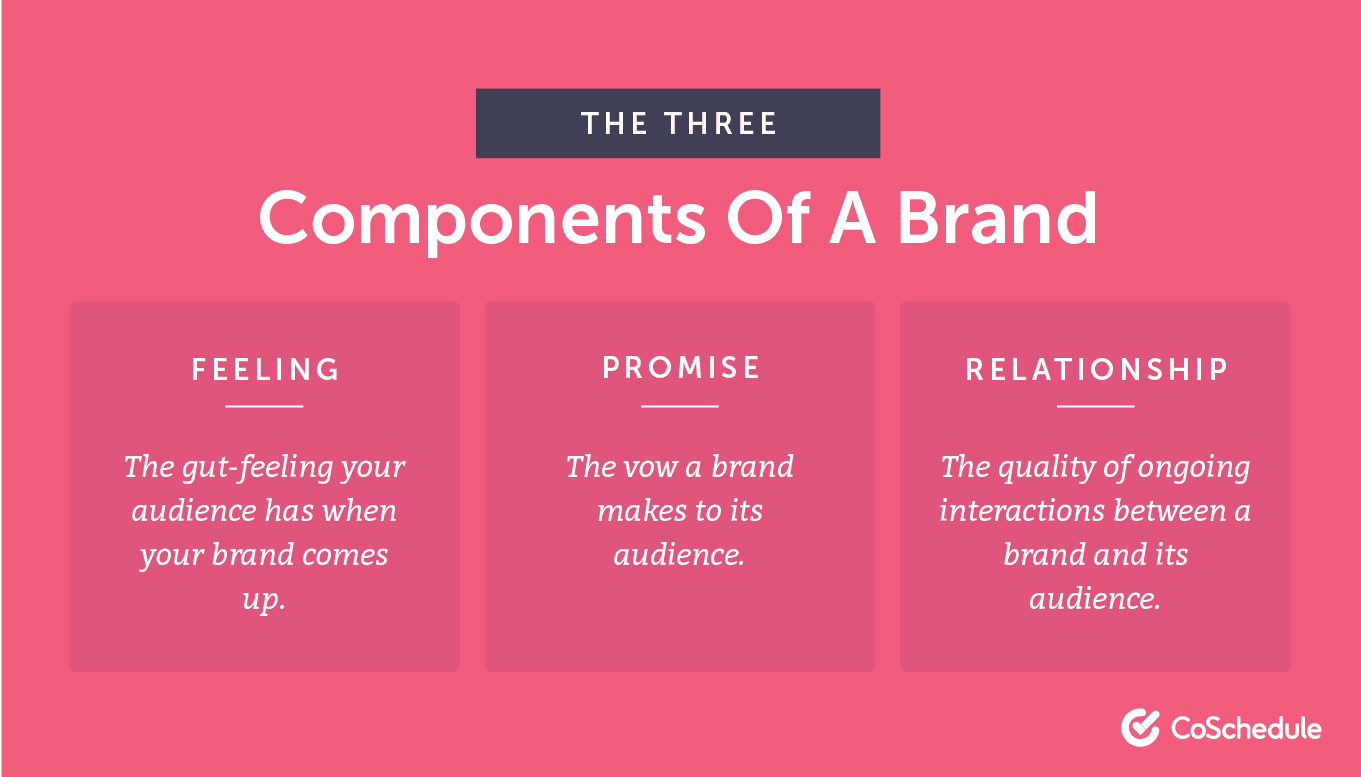
What is a Brand Strategy?
A brand strategy is a master plan for connecting your unique value with the right audience every time you cross paths.
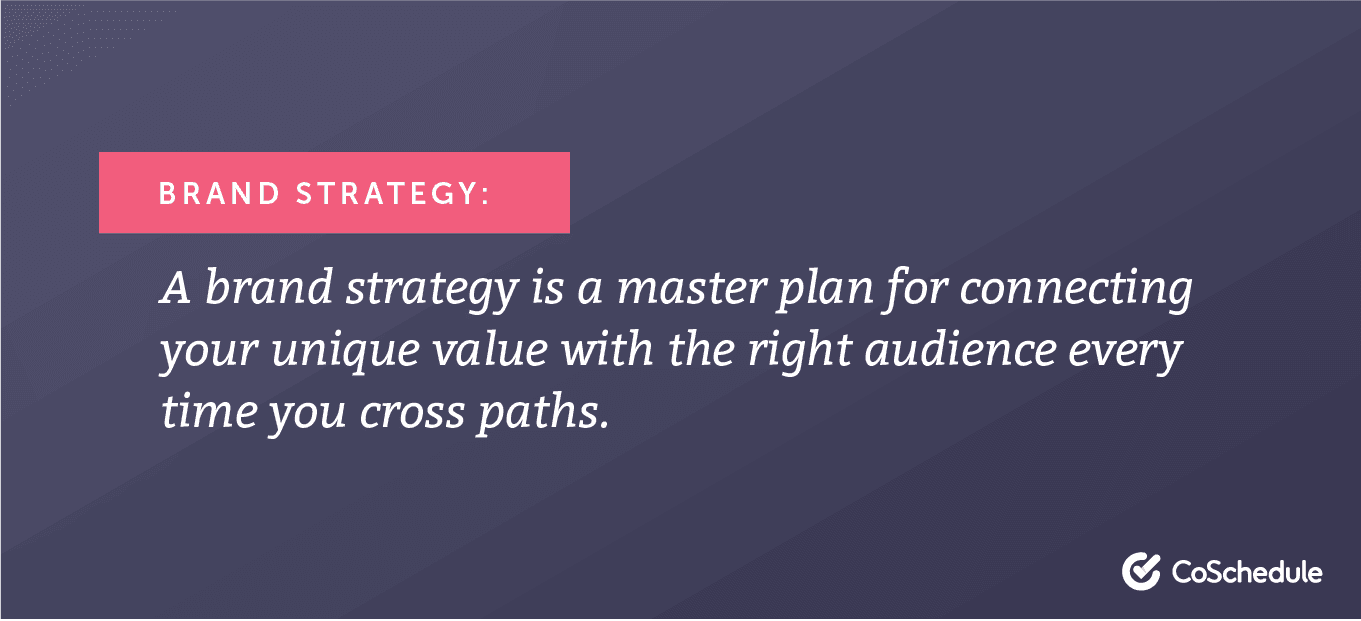
This one’s called the story-source brand strategy.
It’s the perfect place to start or pivot, and it will:
- Connect your brand to the right people. By defining your audience persona and outlining their challenges, you’ll learn exactly how to craft messaging that resonates with them.
- Unify your brand across every channel. By knowing how you can add unique value to your audience, you can continually make a giant, compelling, and true brand promise. This is the secret sauce to nurturing an enviable and profitable relationship with your audience.
- Infuse your marketing with purpose and excitement. Marketing is about driving profitable customer action, but the best way to do this isn’t by soullessly pushing products and services at anyone with a pulse. It’s about tapping into the powerful reason why you truly love helping your audience.
Now, it’s time to cut the B.S. out of brand strategy.
[Tweet “How to create a brand positioning strategy that will appeal to the right people.”]
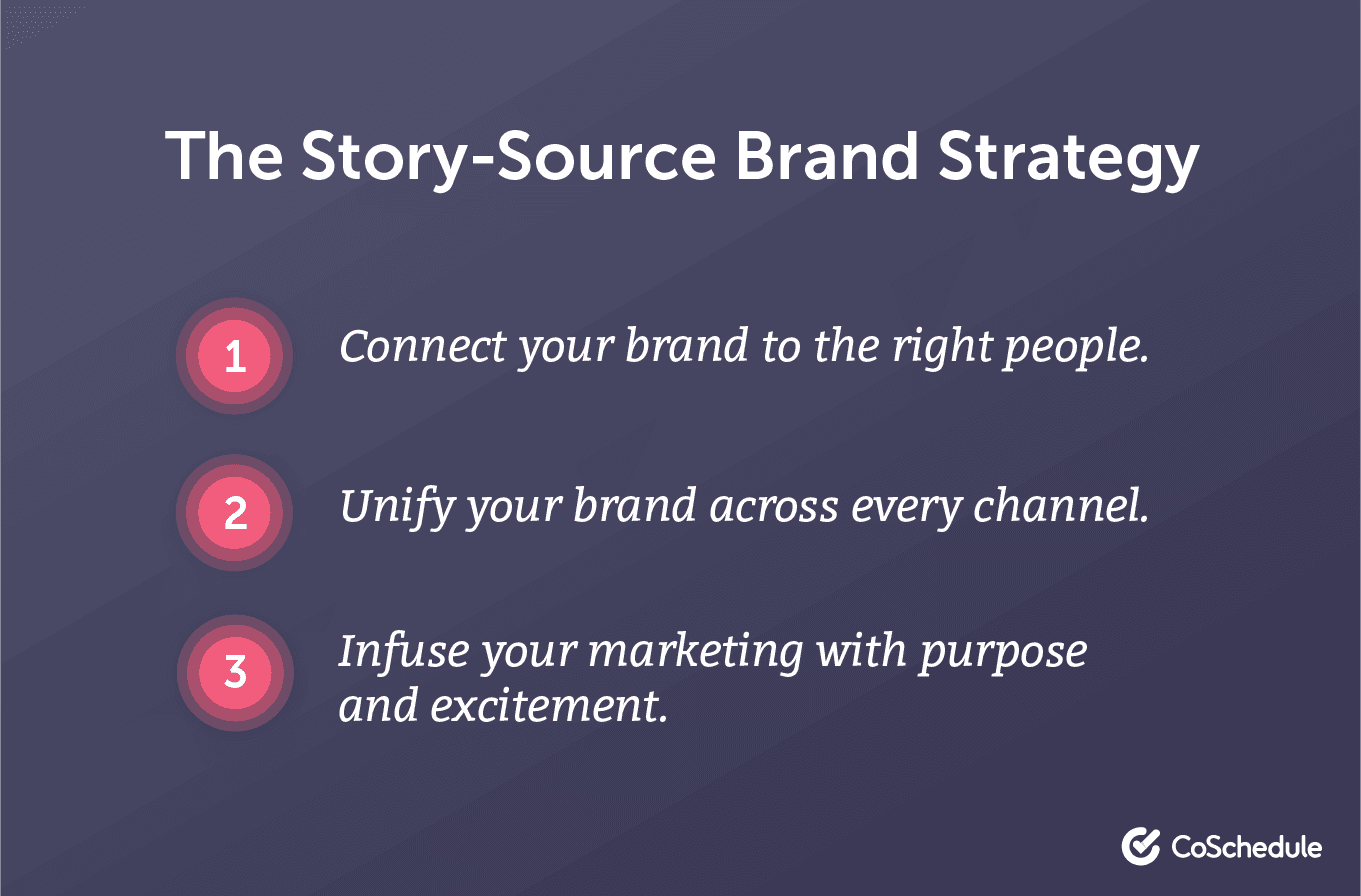
Table of Contents
- Your Brand as a Gut-Level Reaction
- The Sticky-Note Brand Test
- The Brand Promise
- How to Define Your Brand Positioning
- Making Good On Your Brand Promise
- How to Measure Your Brand Sentiment Score
[content_upgrade_shortcode]
Your Brand as a Gut-Level Reaction
In his illuminating book, The Brand Gap, Marty Neumeier says, “A brand is simply a gut feeling and a promise.”
Your brand equals the gut-feeling your audience has when your company’s name comes up. It’ll be different for everyone, but here’s a quick test.
[Tweet “Your brand equals the gut-feeling your audience has when your company’s name comes up.”]
Grab three sticky notes and lay them side-by-side.
Now, write these three brand names, one per note:
- Fruit of the Loom
- Calvin Klein
- Victoria’s Secret
Even though each brand sells similar products, they evoke different gut-level reactions. This is the first secret of what a brand is and how it works.
The Sticky-Note Brand Test
Grab three more sticky notes. Write your brand’s name on one and your two main competitors’ on the others — one name per note.
Take them to someone who knows something about each brand. Ideally, this would be someone outside of your company.
Lay the sticky notes in front of them, one at a time. Then ask for the first word or feeling that pops into their mind upon seeing the brand name.
Start with your competition, then move to yours. Compare the words they gave you, then ask, “Can you explain why?”
If possible, do this test a few more times and compare results.
As you do, ask yourself three questions:
- What patterns emerge?
- Am I happy with the honest, gut-level reactions to my brand?
- What can we do to make them better?
The Brand Promise
Second, a brand is the promise an organization makes to its audience.
There’s a popular marketing saying that goes, “A brand is a promise made. A great brand is a promise kept.”
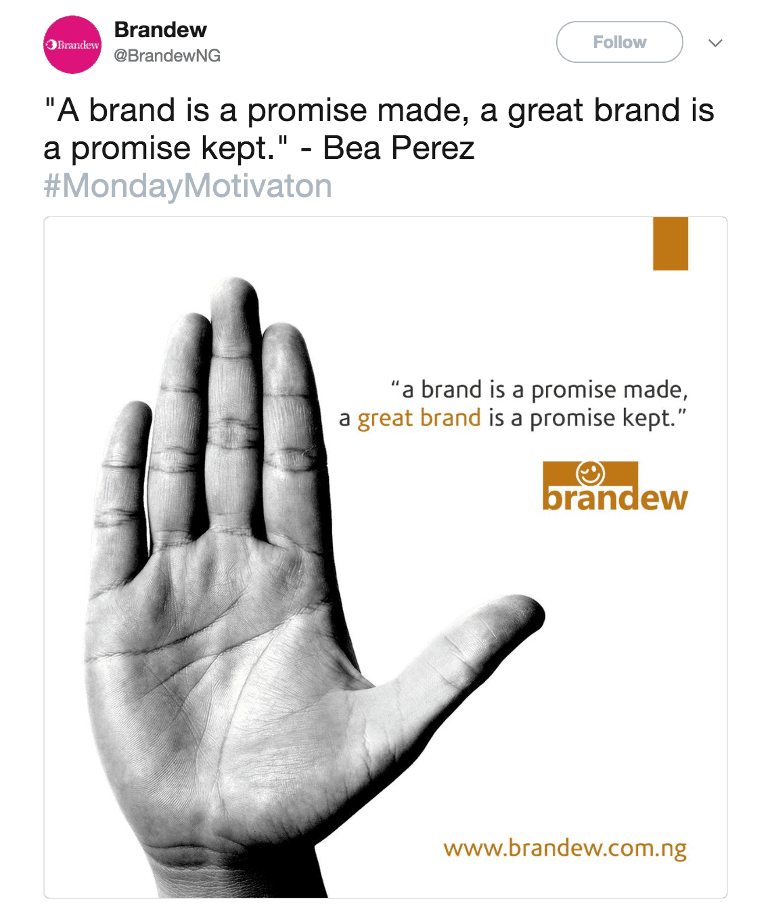
It appears that Bea Perez of Coca-Cola originally turned this phrase.
Case-in-point, Google’s famous mission “to organize the world’s information and make it universally accessible and useful.”
Is Google making good headway on this mission? This promise?
When it comes to news, more people trust Google than traditional media outlets. When it comes to organizations, Google Drive sports more than one million paid users.
That’s a lot of people trusting Google to be honest with the information they present and the data they store.
Sure, some techy folks don’t trust Google with their data, but the numbers are an avalanche of trust in the brand. Consumers and businesses believe Google’s promise. Why? Because they’re doing well with it.
How to Define Your Brand Positioning
Brand positioning happens whether or not you intentionally incorporate it into your marketing strategy. You can proactively influence this perception by planning your brand positioning before you publish content — therefore, before you define your brand voice.
Consider these key factors as you define your brand positioning:
- Relevancy
- Uniqueness
- Credibility
The following exercises will help you write your brand positioning statement, like this example template:
{Insert target audience} trust {insert your brand} as the {insert unique product or service category} that {insert primary benefit} because {insert your brand} is the best way to {insert credibility statement}.
Relevancy
How can you make your brand relevant to your prospects?
[Tweet “How can you make your brand relevant to your prospects?”]
You’ve already done much of the leg work to understand the emotional reasons why your customers choose your product or service. In your customer survey, explore the answers to the following questions:
- What is the primary reason you use {insert your product or service}?
- Why did you choose {insert your product or service} over other solutions?
- What is the most significant difference {insert your product or service} is making for you today?
- What is the single greatest benefit {insert your product or service} provides?
- You could also ask, “What is the primary benefit you have received from {insert your product or service}?”
- What prompted you to look for a solution like {insert your product or service}?
Copy the answers from those questions and paste them into a word cloud generator.
From here, analyze the most commonly-used words that describe your product/service and its benefits or the emotional reasons why your customers buy from you.
For example, this is what it looks like for CoSchedule:
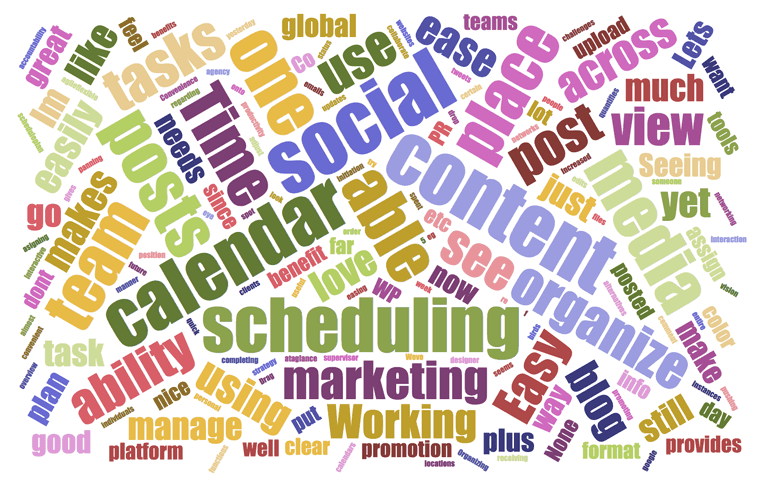
Use this visualization to determine your primary benefit.
What is the #1 reason your customers hire your product or service?
In this example, CoSchedule’s primary benefit is ease + organize.
Enter your relevancy statement in cell B3 in the Brand Positioning + Voice tab from your marketing strategy template.
Uniqueness
How will your brand stand out from your competition?
In your customer survey, you asked the question:
If you didn’t use {insert your product or service}, what would you most likely use instead?
OR
What would you likely use as an alternative if {insert your product or service} were no longer available?
The answers provided are the names of your top competition. At this point, review their websites for their brand positioning.
Review for qualities like:
- Taglines
- Headlines
- Keywords
- Common verbiage
Now, brainstorm how your brand positioning will be uniquely different:
- How would you define your product or service to someone outside of your industry?
- How would you define your product or service to someone in your niche who’s never heard of it but is familiar with industry lingo?
- How do you envision your product or service is different from your competition?
You may also opt to look into your customer survey data for answers to this question:
How would you (briefly) describe {insert your product or service} to someone else?
Then enter that information in a word cloud generator to understand the most commonly used words. This practice will also help keep your product or service category relevant in your brand positioning statement.
For example, this is what it looks like for CoSchedule:
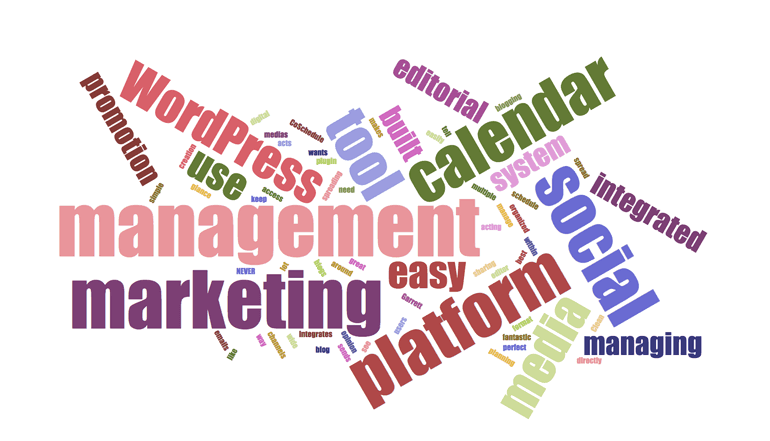
Use this process to determine your unique product or service category.
What words describe your product or service?
For example, CoSchedule’s unique service category is a marketing management platform.
Enter your uniqueness statement in cell B4 in the Brand Positioning + Voice tab from your marketing strategy template.
Credibility
Why should your target audience trust your brand? Why should they believe your brand will deliver the benefit better than any competitor?
Look at the answers for these questions in your customer survey — the same questions you reviewed for your primary benefit.
This time around, you’re looking for words that describe why your customers trust you. The framework to follow is this:
- {Insert your brand} is the only {insert credibility statement}.
- {Insert your brand} is the best {insert credibility statement}.
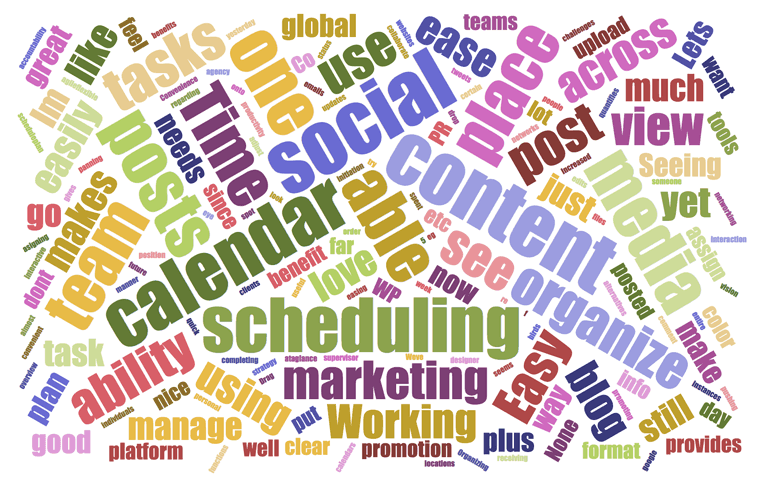
Use this visualization to determine your credibility statement.
What makes you the most credible brand in your unique product or service category?
For example, CoSchedule’s credibility statement is see + one + place.
Enter your Credibility statement into cell B5 in the Brand Positioning + Voice tab from your marketing strategy template.
Your Brand Promise
What is your brand’s promise? What is your reason for existing?
Write Your Brand Positioning Statement
Let’s bring all three exercises together to help you write your brand positioning statement. Here’s your template again:
{Insert target audience} trust {insert your brand} as the {insert unique product or service category} that {insert primary benefit} because {insert your brand} is the best way to {insert credibility statement}.
For example, here are the results of the three exercises for CoSchedule:
- Relevancy: Ease + organize
- Uniqueness: Marketing management platform
- Credibility: See + one + place
Therefore, the CoSchedule brand positioning statement example using that template looks something like this:
Professional marketing managers trust CoSchedule as the marketing management platform that gets them organized easily because CoSchedule is the best way to see every marketing project in one place.
Enter your brand positioning statement in cell B7 in the Brand Positioning + Voice tab from your marketing strategy template.
Can you finish that statement? Even more, do you really believe that you’re fulfilling this promise?
The degree to which you fail to fulfill your promise is called the “trust gap”.
Author Scott Stratten explains this in his book, Unmarketing.
He says the trust gap is, “the amount of trust you have to earn before your potential customer will consider buying from you.”
[Tweet “The trust gap is the amount of trust you have to earn before your potential customer will consider buying from you.”]
However, this goes further because not only do you have to earn enough trust to secure a purchase, you have to keep it along the way.
Bill Kobel said, “The real fallout of breaking your brand promise is loss of trust. Once you lose trust, you have to work twice as hard to earn it back — if you can.”
How does a brand win trust?
Enter the brand-audience relationship.
The Relationship Between a Brand and Its Audience
Here’s the deal. Marketing is all about driving profitable customer action, and brand strategy shares this goal — especially when it comes to your relational health.
At this point, you might think I’m going to provide you the number of a therapist or start asking you questions about your childhood, but I’ll leave the sappy stuff for another day 
Instead, let’s talk about concrete ways to do a health check on your brand-audience relationship.
This relationship can be measured by the quality of ongoing interactions. These touch points can be anything from your content to ads to physical environment to customer support.
In short, when your audience interacts with any facet of your brand, the relationship is either helped or harmed.
How to Measure Your Brand Sentiment Score
CoSchedule measures the health of our brand-audience relationship by keeping track of three different metrics — other brands should pay close attention to them, too.
They are audience growth, engagement rates, and sentiment.
While each is important, I think the clearest indicator of relational health is sentiment.
Sentiment measures the weight of positive, neutral, and negative mentions of your brand. PR folks use tools, like Mention and Cision, to peer into the sentiment Pensieve.
CoSchedule uses Mention, so here is how to run a sentiment analysis using this method.
To begin, log in to your Mention account and select Dashboard.

Next, select Listening Analysis.”

Now, you’ve arrived at your Listening Dashboard, where you can track mentions by channel, the times people talk about you the most, and of course…
How your audience really feels about you!
For example, here’s what our sentiment score looks like over a recent, seven-day period:
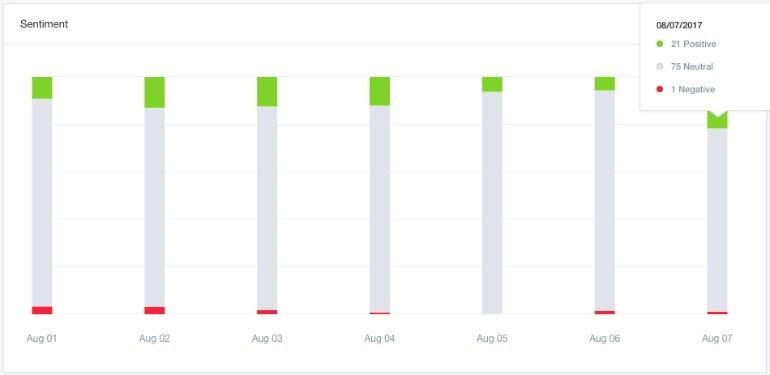
Each bar represents the total mentions for a given day.
The green segments show positive mentions, gray shows neutral ones, and the red are the ones you don’t enjoy seeing (i.e. negative mentions).
I ran this report on the afternoon of August 7, 2017. Up to that point, CoSchedule had 97 trackable mentions.
Of which, 21.6% were positive, 77.3% were neutral, and about 1% were negative.
Pro Tip: Neutral mentions are often shares or similar engagements. However, they’re worth combing through with a human eye. This way, you can find and mark positive mentions the tool may have misinterpreted. Additionally, always look closely at your negative marks. For instance, if someone tweeted, “CoSchedule is sick!” that may be counted as a negative mention. When in reality, it’s a good thing.
Overall, a healthy audience is one that’s growing, engaged, and speaking positively about your brand.
From a brand strategy perspective, one of the best ways to nurture this kind of relationship is by simply fulfilling the brand promise you make.
Beyond having a great product, your customer service will go leagues in building a stellar brand.
At CoSchedule, the Customer Success Team is absolutely killer in this department. From onboarding to support, they’re nearly flawless at executing our brand promise.
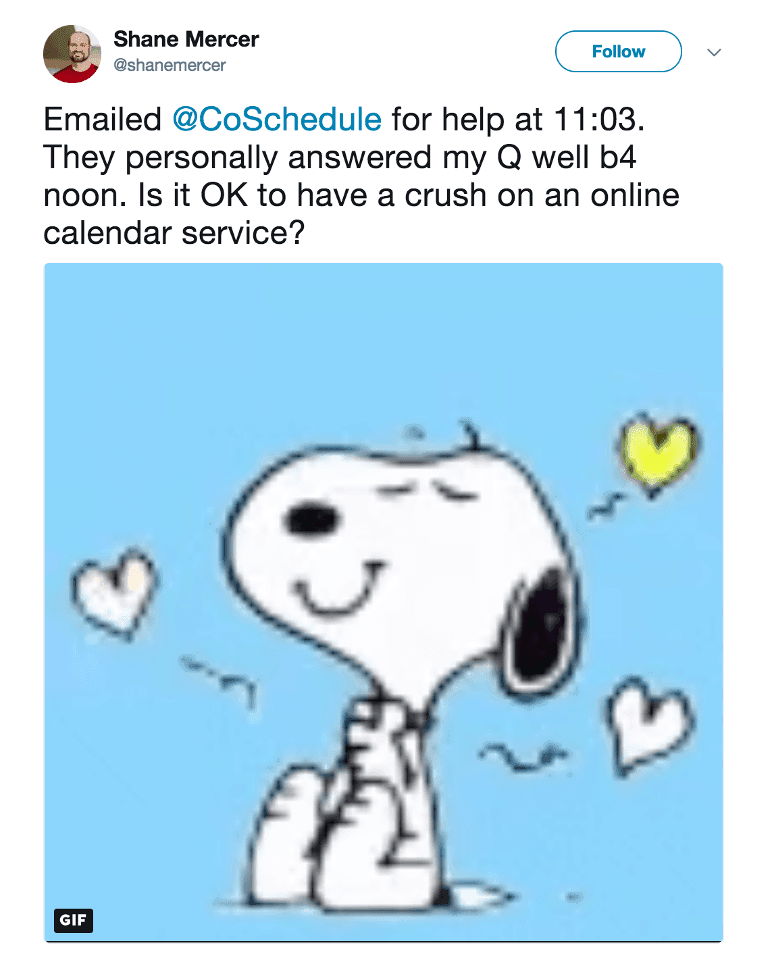
Brand Strategy: Where Most Go Wrong
The old way of branding is “Me-Centric”.
It’s about talking “at” people with the primary topic being… yourself.
You know, straight up self-promotion masquerading as branding.
The question brands need to ask themselves is, “How does our message reinforce and fulfill the value we’ve promised to deliver?”
To do this, brands must adopt a “You-Centric” model.
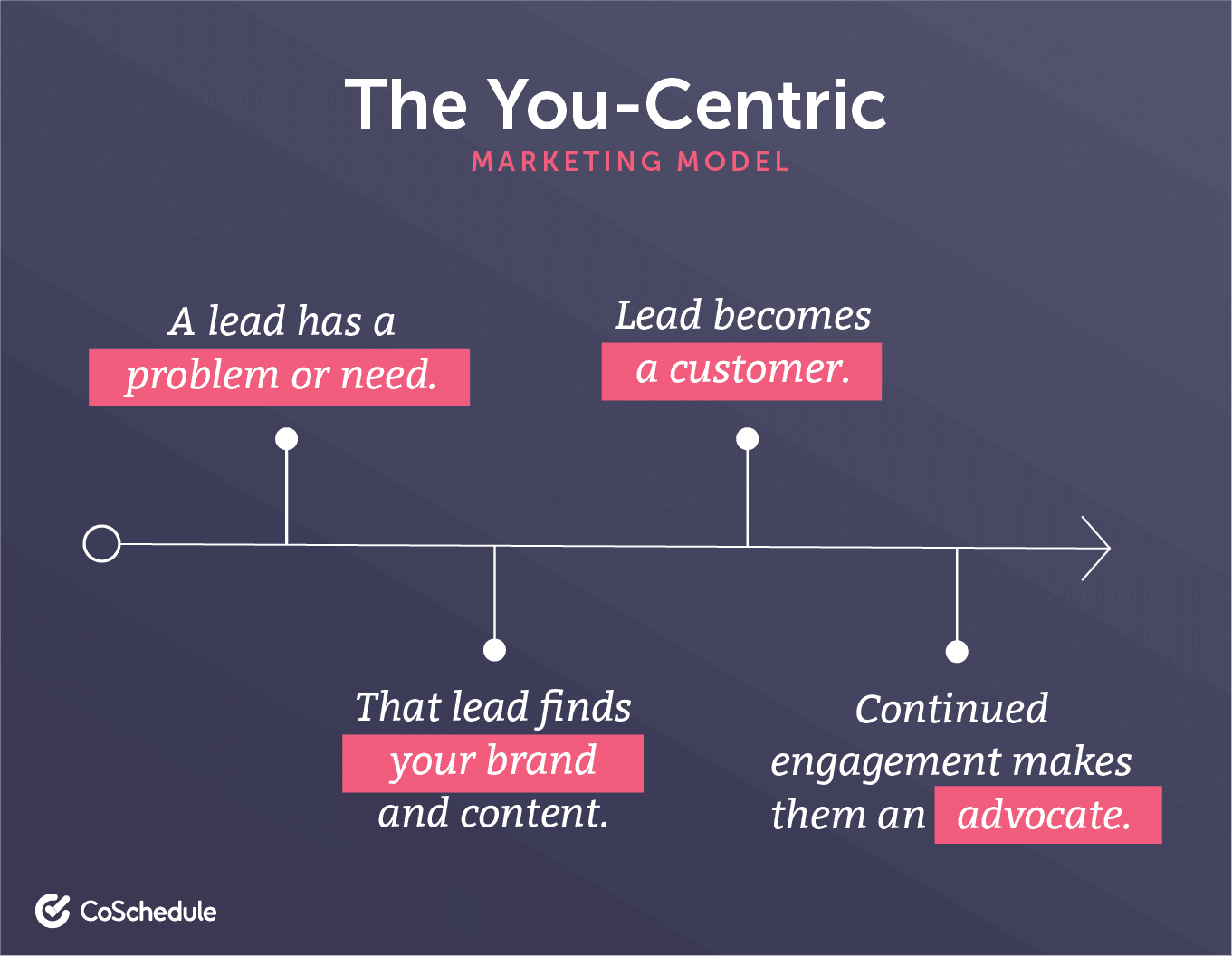 Jay Baer explained this perfectly in his book, Youtility.
Jay Baer explained this perfectly in his book, Youtility.
He wrote, “What if, instead of trying to be amazing, you just focused on being useful? What if you decided to inform, rather than promote?”
To hyper-focus on the right people, open up the audience persona template included in your free kit.
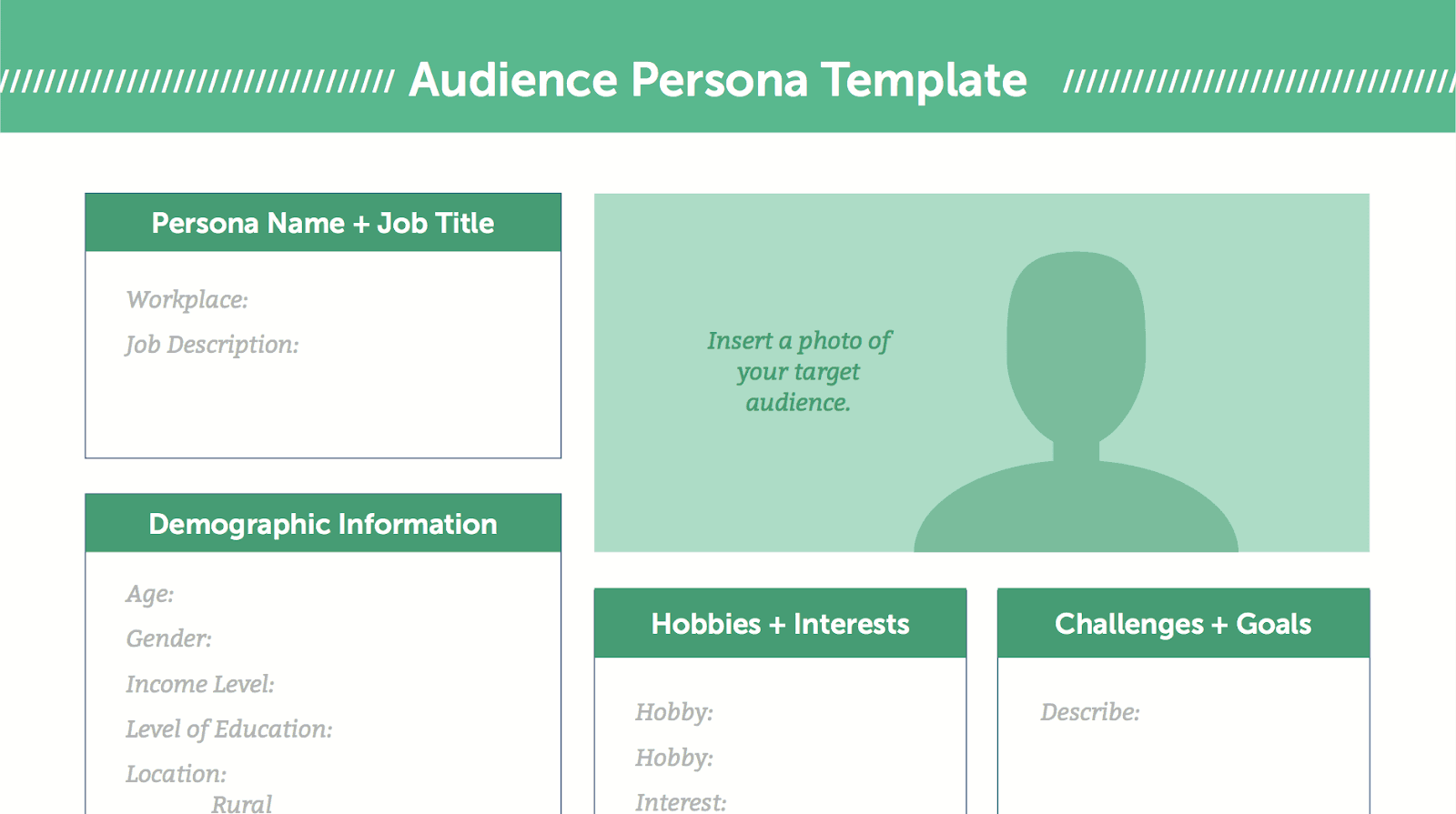
As you answer the questions in the workshop, you will define exactly who your target audience is and what they’re interested in. You’ll also work through your brand positioning statements.
Most importantly, you will outline their primary challenges and goals. These serve as the fuel to your brand’s fire.
Why? Because, just as Jay Baer said, it’s about being useful and informative.
Your persona(s) is where you define exactly how you can do both because that’s the crux of the story-source brand strategy.
It rests on five tenets:
- Know your audience.
- Know your value.
- Make a true promise.
- Foster a healthy relationship.
- Never stop.
Every tenet leads to the end of a relationship because, put another way, your brand is the quality of the relationship with your audience.
Obviously, you’re not taking your customers to prom — at least, I hope not. In this context, relationship means the stickiness of trust coupled with compelling reasons to return.
[Tweet “A relationshipin marketing means the stickiness of trust coupled with compelling reasons to return.”]
It’s as dear Uncle Aristotle observed, “Man is a social animal…”
That’s how we’re psychologically wired. Don’t view it as irrelevant or non-professional; embrace it as your new touchstone for approaching your audience in a way that works.
Sure, you’ll talk about yourself — you have to. If you don’t, there’s no relationship. However, you should always do so from the perspective of how you’re responding to their needs.
How are they the source of your story? The hero of your narrative?
The story-source strategy creates a compelling, coherent, and flexible message. It’s simple at its core, yet can be layered in complex ways without sacrificing clarity.
Brand Strategy From the Storytelling Masters
Coca-Cola is one of the world’s most valuable and recognizable brands.
Coke ranks sixth on Interbrand’s top 100 global brands list — trailing tech luminaries Apple and Google.
That’s pretty phenomenal company to keep.
Their brand strategy, simply called “One Brand,” unifies the beverage giant’s global brand. In fact, they’ve distilled their brand story into just three words: “Taste the feeling.”
This strategy marries closely with their content marketing approach, called “Content 2020”.
One of the keys to their carbonated kingdom is called dynamic storytelling.
Here’s their pretty technical definition:
Dynamic storytelling is the development of incremental elements of a brand idea that get dispersed systematically across multiple channels of conversation for the purpose of creating a unified and coordinated brand experience.
Allow me to translate.
Dynamic storytelling means sharing your story-source everywhere, at all times, and via every appropriate medium.
Your “story” isn’t simply your company’s history, it’s not just about your culture, and it’s more than customer testimonials.
It’s the narrative of how you help your audience overcome their problems to get what they most deeply desire.
The Strategy at Work in Advertising
Let’s dissect a great example from the classic “Guinness Guide to Oysters” ad created by David Ogilvy in 1951.
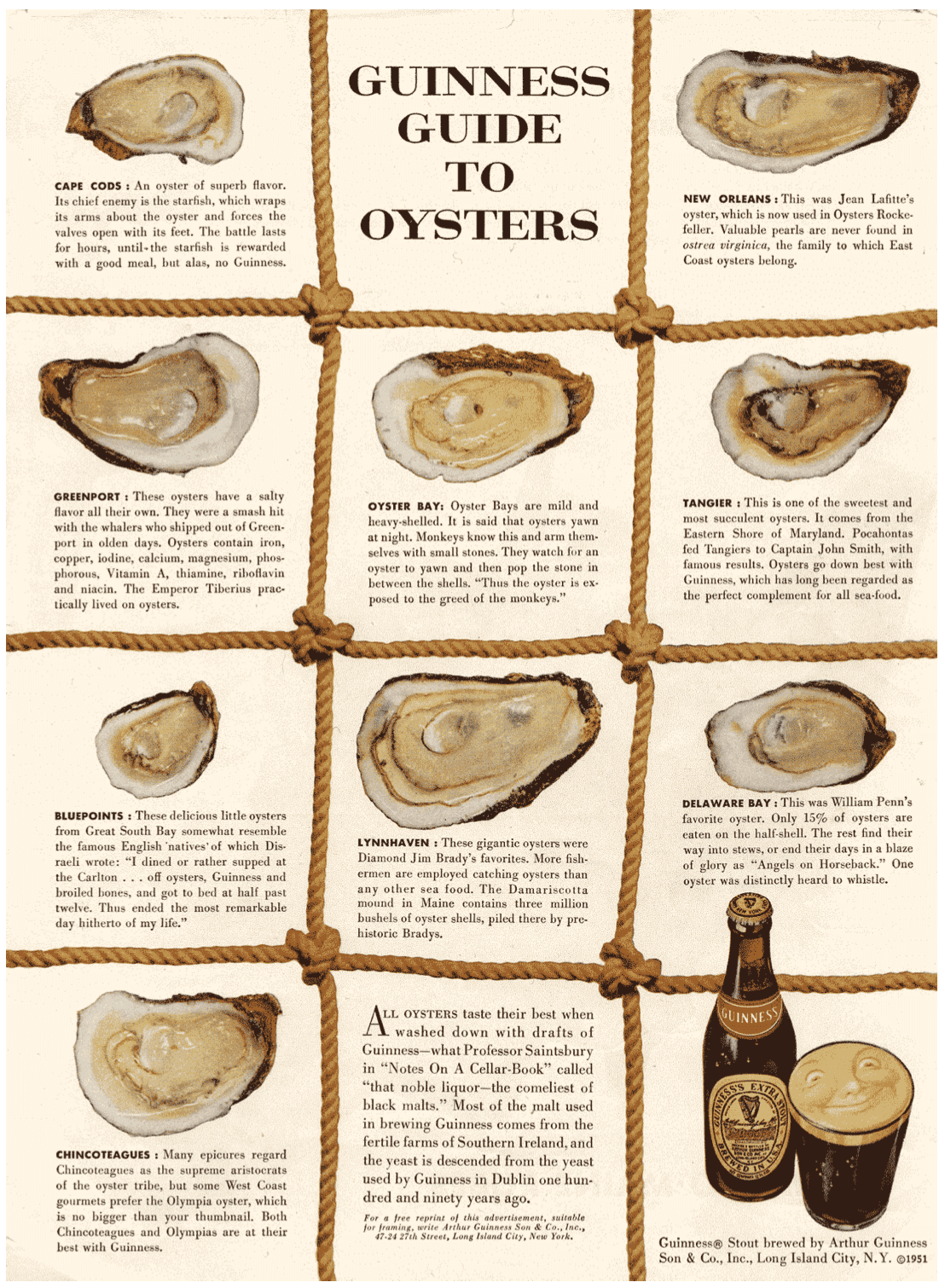 Source: Ogilvy On Advertising
Source: Ogilvy On Advertising
This is one of my all-time favorite ads. Notice that it does all of the things a story-source brand strategy should do.
It talks with their audience, educating them on how to enjoy a delightful meal. In fact, only four of the ten sections of the copy even reference Guinness.
Instead, they create mystique, and sections such as “Delaware Bay” make the implicit promise that, “If you do this, you’ll be like William Penn.”
Not only are they promises of an enjoyable meal, they’re promises of being a culinary insider — an impressive and classy connoisseur.
There’s magic here that deepens the relationship between customer and brand.
They speak directly into the hearts and bellies of their target audience. This makes them the heroes of the story.
Go Forth and Brand!
Gary the cow certainly wishes he would have had our brand strategy to work with. Thankfully, we don’t have to go through the pain and confusion branding can evoke.
Work the process, ask the tough questions, and answer them honestly.
As you do, remember the five tenets of this brand strategy:
- Know your audience.
- Know your value.
- Make a true promise.
- Foster a healthy relationship.
- Never stop.
You’re well on your way to successful branding that appeals to the right people.
Happy marketing! 
Leah DeKrey was the original author of this post. Peyton Muldoon edited and updated the content on October 23, 2020. There is still content concerning Leah’s original title and last name, since her time with CoSchedule, that needs changing.
The post How To Create A Brand Positioning Strategy That Will Appeal To The Right People appeared first on CoSchedule Blog.

